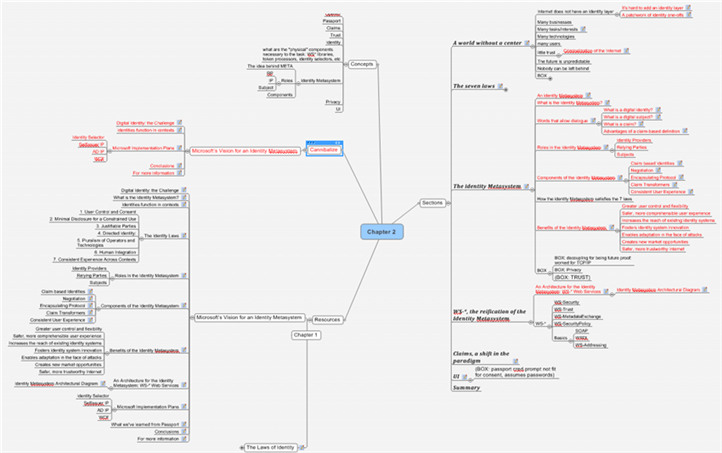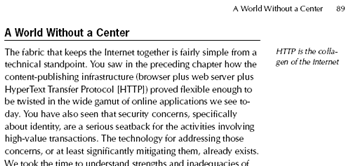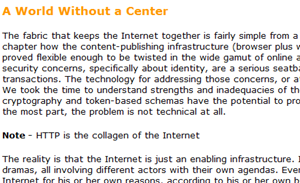The entire chapter 2 of "Understanding Windows CardSpace" published on Code Project
Few days ago I've been notified that the 2nd chapter of our book "Understanding Windows CardSpace" is now available for free online, on the pages of Code Project (takes some time to load from my connection, don't give up).
That's a very big chapter, for architects and business decision makers, focused on showing how the identity laws and the identity metasystem are addressing many of the challenges presented in chapter 1. It also shows the role played by WS-Trust & friends. There's not much of Windows CardSpace in this chapter, apart from its positioning as the identity selector that comes with Windows: in fact I like to think that the same text could have been used in a book about Higgins or any of the of the projects in this space. (BTW, Paul says extremely kind things about the book here. Thank you Paul!).
Many of the topics in the chapter do not have a natural order of presentation, but they all sort of depend from one another in a way which was pretty difficult to disentangle. Furthermore it is important to introduce all the new concepts in the right context, in a coherent discussion, without forgetting anything important just because you approached the matter form one angle rather than another. To give you an idea of the planning effort it required, I fished from my archives one of my mindmaps for this chapter:

Pretty wide, eh? I just *love* MindManager!
See, that's the essence of a discussion I had almost one year ago with my good friend Gianpaolo. We were discussing what are the merits of writing a book in year 2007, especially when you already have a blog that reaches a wide audience. The mindmap above makes exactly the point I was making during that discussion. None of my posts are so thoughtfully planned, peer-reviewed, researched, discussed, tested, proofreaded, sanitized. The blog is a spontaneous brain dump, which is good for keeping the conversation, streaming new ideas or for isolated information nuggets. A book delivers a different experience, at a different pace: reading it provides its own context, continuity as opposed to the eternal partial attention of reading a post side by side to hundreds of others in the RSS aggregator. So yes, I think that writing a book still makes a lot of sense: it can satisfy a different audience, or the same audience for different purposes. Besides, it was really a satisfaction to finally tell the story in the way we wanted (even if it's never exactly like you want, otherwise it would never come out) :-)
But I digress. The chapter stands on its own, and if you are already familiar with the problem and the technologies at play you can certainly read it without loss in meaning (apart for specific concepts, like the idea of hostage identity, introduced in chapter 1); anyway, it probably makes more sense if read after having acquired the right context presented in chapter 1 (you'll notice many references to chapter 1 sprinkled through the text).
Also: you'll find some "notes" here and there in the text, seemingly without much context: that's an artifact of how the margin notes typical of the series are rendered on a webpage or in the book. Below a little comparison:
 |
 |
That's it. I am somewhat biased, but I hope that you'll find value in this chapter. If you are not familiar with the Laws or the identity metasystem we explain both in great length, assuming only the knowledge that we gave in chapter 1. If you are already familiar with those two, you can still find deeper and/or subtle considerations (like how to explain the difference between outsourcing authentication and accepting tokens form a partner) that I hope will elicit some meditation (or stir controversy :) I plan to revisit & expand that in a post).
Finally, let me remind you one super important thing I already said in some private mail exchange.
True, Caleb Garrett and I are Microsoft employees: however we entered in this endeavor trying to be as independent as possible.
- The authors decided what to write, from the initial TOC proposal to the last review cycle. Our colleagues such as Mike or Kim saw the book once it was practically done. In other words, the book does not reflect the official Microsoft position but rather it is a snapshot of the experience of the three authors. It is true that this experience has been developed inside Microsoft, and that we owe really a lot to our continual ideas exchange with our colleagues: but ultimately nobody told us what to say, nor we would have allowed that. We welcome (no, we look forward for) feedback from anybody, and we’d take swift corrective actions for any inaccuracy brought to our attention, but at the end of the day what ends up in the text is our responsibility :-)
- All our technical reviewers (Eric Ray, Dominick Baier, Greg Shields. Thank you again guys!) were from outside Microsoft
- The book is published by Addison Wesley, not MSPress
- The name of the series we are in is, after all, Technology Independent Guides
That said, enjoy :-)